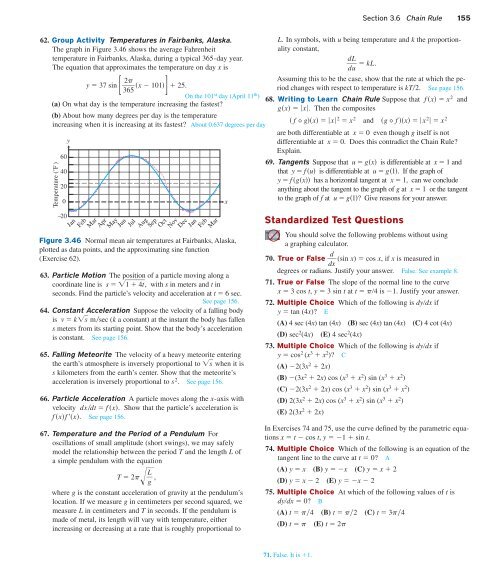5128_Ch03_pp098-184
You also want an ePaper? Increase the reach of your titles
YUMPU automatically turns print PDFs into web optimized ePapers that Google loves.
Section 3.6 Chain Rule 155<br />
62. Group Activity Temperatures in Fairbanks, Alaska.<br />
The graph in Figure 3.46 shows the average Fahrenheit<br />
temperature in Fairbanks, Alaska, during a typical 365-day year.<br />
The equation that approximates the temperature on day x is<br />
y 37 sin<br />
[ 2p<br />
x <br />
365<br />
101] 25.<br />
On the 101 st day (April 11 th )<br />
(a) On what day is the temperature increasing the fastest?<br />
(b) About how many degrees per day is the temperature<br />
increasing when it is increasing at its fastest? About 0.637 degrees per day<br />
Temperature (˚F )<br />
60<br />
40<br />
y<br />
20<br />
0<br />
....... . . ... ... . . .... . . .. .<br />
–20<br />
Jan<br />
Jun<br />
Jul<br />
Feb<br />
Mar<br />
Apr<br />
May<br />
...... .. ....... ..... ........ .... . ...<br />
... . .<br />
.. . ........... . .. .... .........<br />
........<br />
.<br />
Jan<br />
Aug<br />
Sep<br />
Oct<br />
Nov<br />
Dec<br />
....<br />
Feb<br />
Mar<br />
Figure 3.46 Normal mean air temperatures at Fairbanks, Alaska,<br />
plotted as data points, and the approximating sine function<br />
(Exercise 62).<br />
63. Particle Motion The position of a particle moving along a<br />
coordinate line is s 1 4t, with s in meters and t in<br />
seconds. Find the particle’s velocity and acceleration at t 6 sec.<br />
See page 156.<br />
64. Constant Acceleration Suppose the velocity of a falling body<br />
is v ks msec (k a constant) at the instant the body has fallen<br />
s meters from its starting point. Show that the body’s acceleration<br />
is constant. See page 156.<br />
65. Falling Meteorite The velocity of a heavy meteorite entering<br />
the earth’s atmosphere is inversely proportional to s when it is<br />
s kilometers from the earth’s center. Show that the meteorite’s<br />
acceleration is inversely proportional to s 2 . See page 156.<br />
66. Particle Acceleration A particle moves along the x-axis with<br />
velocity dxdt f x. Show that the particle’s acceleration is<br />
f xf x. See page 156.<br />
67. Temperature and the Period of a Pendulum For<br />
oscillations of small amplitude (short swings), we may safely<br />
model the relationship between the period T and the length L of<br />
a simple pendulum with the equation<br />
T 2p <br />
L g ,<br />
where g is the constant acceleration of gravity at the pendulum’s<br />
location. If we measure g in centimeters per second squared, we<br />
measure L in centimeters and T in seconds. If the pendulum is<br />
made of metal, its length will vary with temperature, either<br />
increasing or decreasing at a rate that is roughly proportional to<br />
x<br />
L. In symbols, with u being temperature and k the proportionality<br />
constant,<br />
d L<br />
kL.<br />
du<br />
Assuming this to be the case, show that the rate at which the period<br />
changes with respect to temperature is kT2. See page 156.<br />
68. Writing to Learn Chain Rule Suppose that f x x 2 and<br />
gx x. Then the composites<br />
f gx x 2 x 2 and g f x x 2 x 2<br />
are both differentiable at x 0 even though g itself is not<br />
differentiable at x 0. Does this contradict the Chain Rule?<br />
Explain.<br />
69. Tangents Suppose that u gx is differentiable at x 1 and<br />
that y f u is differentiable at u g1. If the graph of<br />
y f gx has a horizontal tangent at x 1, can we conclude<br />
anything about the tangent to the graph of g at x 1 or the tangent<br />
to the graph of f at u g1? Give reasons for your answer.<br />
Standardized Test Questions<br />
You should solve the following problems without using<br />
a graphing calculator.<br />
d<br />
70. True or False (sin x) cos x, if x is measured in<br />
d x<br />
degrees or radians. Justify your answer. False. See example 8.<br />
71. True or False The slope of the normal line to the curve<br />
x 3 cos t, y 3 sin t at t p4 is 1. Justify your answer.<br />
72. Multiple Choice Which of the following is dydx if<br />
y tan (4x)? E<br />
(A) 4 sec (4x) tan (4x) (B) sec (4x) tan (4x) (C) 4 cot (4x)<br />
(D) sec 2 (4x) (E) 4 sec 2 (4x)<br />
73. Multiple Choice Which of the following is dydx if<br />
y cos 2 (x 3 x 2 )? C<br />
(A) 2(3x 2 2x)<br />
(B) (3x 2 2x) cos (x 3 x 2 ) sin (x 3 x 2 )<br />
(C) 2(3x 2 2x) cos (x 3 x 2 ) sin (x 3 x 2 )<br />
(D) 2(3x 2 2x) cos (x 3 x 2 ) sin (x 3 x 2 )<br />
(E) 2(3x 2 2x)<br />
In Exercises 74 and 75, use the curve defined by the parametric equations<br />
x t cos t, y 1 sin t.<br />
74. Multiple Choice Which of the following is an equation of the<br />
tangent line to the curve at t 0? A<br />
(A) y x (B) y x (C) y x 2<br />
(D) y x 2 (E) y x 2<br />
75. Multiple Choice At which of the following values of t is<br />
dydx 0? B<br />
(A) t p4 (B) t p2 (C) t 3p4<br />
(D) t p (E) t 2p<br />
71. False. It is 1.












